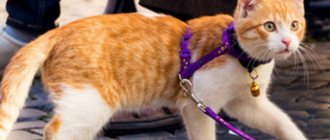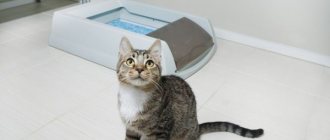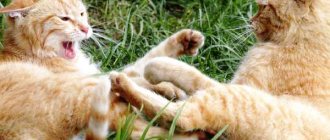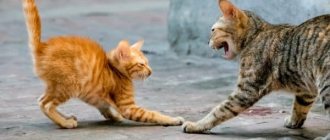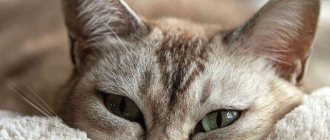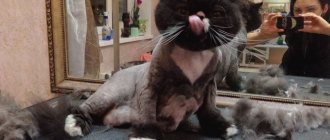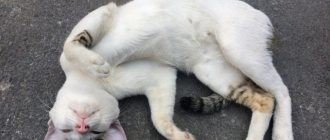A cat walking in circles may need your attention. This is a common cat greeting, especially if it is followed by rolling on the floor. There are also health problems that can lead to circling in cats.
Your cat may be walking in circles due to vestibular disease, a condition that affects the inner ear. This condition will disappear after 24 hours. Check for hypertension, hypoglycemia, and inner ear infection. If a cat circles after a head injury, perhaps due to a fall, it may suffer a concussion. Older cats may become dizzy due to dementia, a condition that causes significant confusion and disorientation.
A cat circling around you could be a sign that your cat is really happy to see you, or that she is just joking. However, it is important to note other unusual behaviors that your cat has not previously exhibited.
Causes
Some cats love to greet their owners. If your cat rubs against your legs after circling, this is likely. Your cat enjoys your presence. She demands attention, so offer her light affection.
Perhaps your cat is leading you in a certain direction. He may have discovered something he wants to share with you. For example, he may have a dirty litter box or need to be fed in bed.
There is a small chance that your cat is playing a dominant role. She walks in circles to control where you walk. Dominance may begin with circling and then develop into aggression.
© shutterstock
If your cat shows signs of disorientation during or after circling, it is likely more serious. Common health complications include:
- Vestibular disease
- Ear infections
- Head injury
- Hypertension
- Hypoglycemia
- Cognitive dysfunction
- Brain tumors
Let's look at each of these explanations in more detail.
Screaming cat: behavioral characteristics or a sign of illness?
Some cats have an amazing talent: to scream in a voice that is not their own for days and nights. Sometimes this behavior seems strange and unreasonable to the owners. Indeed, it is not always possible to understand why a cat yells, especially a healthy and neutered one. But you still have to try to figure this issue out.
Why can a cat yell?
Your pet's loud cries can be heard at any time: in the middle of the night or in the morning. Some vocalize during the day. And there are also those who are able to scream around the clock. For animals of the Oriental breed this is the norm, but for other pussies there is always a good reason for such behavior.
During the period of heat, all non-sterilized cats scream without exception. The desire to have offspring is so strong that it causes the animal not only psychological, but also physical torment. The same fate awaits a cat if it is not neutered.
In addition, during mating, a loud cry is a signal for an individual of the opposite sex. The cat reports that he is full of strength, energy and longs for love. Of course, a constantly screaming animal causes discomfort to the owners, especially if concerts take place in the morning or at night. But this is a natural phenomenon that cannot be fought. All you have to do is wait patiently for the difficult period to end.
If an old cat constantly yells, he may have Alzheimer's disease or a nervous disorder. This is a consequence of irreversible age-related changes in the animal’s body. The owner should consult a veterinarian. There are a number of medications that can alleviate your pet’s condition and help him calm down, at least for a while.
The heart-rending cry of a young cat may indicate some kind of injury or severe pain. Perhaps the animal is experiencing acute pain in the abdomen. The owner will be able to determine this by carefully palpating the cat. Normally, the stomach should be soft and bear
Source
Greetings
Often a cat that walks in circles is simply happy to see its owner. If your cat circles you when you get home, stop and enjoy the attention. A cat offering this greeting will likely exhibit this additional behavior.
- Tail curled up and pointing at you
- The cat will try to rub its head against your shins and legs.
- Will roll over on his back
- Verbalization
Basically, the cat wants to be acknowledged and petted a little. The spinning usually stops after a few seconds. Otherwise, the cat still wants something from you. Usually it's either food or play.
Treatment Basics
Be that as it may, the treatment of ataxia in cats depends purely on the reasons that caused pathological changes in the animal’s behavior. In case of poisoning
It is important to determine what exactly the animal was poisoned with. In all cases, activated carbon is prescribed, which partially absorbs the toxin, and intravenous administration of supporting compounds is practiced.
If the reasons for a cat’s somewhat inappropriate behavior lie in a “dose” of catnip or valerian
, there is no need to worry: within a few minutes the effect of the substances will end and the animal will become normal again.
For traumatic brain injuries
or even suspicions about them, you need to urgently take the cat to the veterinarian. He will assess the condition of the animal. If the brain has been damaged, there is a high probability of death, or the animal turning into a “vegetable”. In this case, euthanasia is recommended. In other cases, emergency surgery can save the cat. Similarly - in cases of back injuries, which may in one way or another threaten the integrity of the spinal cord.
Thiamine deficiency
, which is detected using a biochemical blood test, is eliminated by a balanced diet and the exclusion of foods containing thiaminase from the diet. In severe cases, vitamin B1 injections and oral multivitamin preparations may be necessary.
Pack instincts
Cats can exhibit pack instincts. If your cat keeps walking in circles, it may be leading you in a certain direction. Let the cat guide you in this case. Remember, cats have excellent hearing. Perhaps he heard something suspicious that you didn't hear.
Your cat may have seen, smelled or seen something disturbing on your property. Cats are not guardian animals in the traditional sense, but will certainly take steps to protect their territory.
My cat walks in circles.
Or rather, he runs at night. counterclockwise. Passes under the bed, and in a circle along the wall, then again under the bed, and so on a hundred times in a row. It’s getting scary(((who has had this? What does she want? Why is she doing this?
Woman.ru experts
Find out the opinion of an expert on your topic
Nevzorova Sofya Igorevna
Psychologist. Specialist from the site b17.ru
Fortunatova Oksana Vasilievna
Psychologist, Psychosomatologist. Specialist from the site b17.ru
Svetlana Chernyshova
Psychologist, Consultant. Specialist from the site b17.ru
Tropina Natalya Vladimirovna
Psychotherapist. Specialist from the site b17.ru
Natalya Maratovna Rozhnova
Psychologist. Specialist from the site b17.ru
Trukhina Natalya Vladimirovna
Psychologist, Psychologist coach. Specialist from the site b17.ru
Spiridonova Nadezhda Viktorovna
Psychologist. Specialist from the site b17.ru
Inna Kravtsova
Psychologist, Gestalt consultant. Specialist from the site b17.ru
Victoria Pedai
Psychologist. Specialist from the site b17.ru
Domination
The cat does not consider its owner to be a master or boss. Cats consider themselves equal to people. This means that a particularly bossy cat may exhibit dominant behavior.
Walking in circles and blocking are common dominance tactics in cat relationships. The dominant cat determines where the submissive cat can walk. He says, “I choose where you go.”
In some cases, a cat may try to do this to a person. The circle is designed to prevent you from leaving the room. If the cat has been fed and played with, this behavior becomes more likely. According to the cat, you have completed your useful task and need to be reminded of your place in the hierarchy.
© shutterstock
Vestibular disease
Vestibular disease affects the vestibular system, located in the cat's inner ear. Cats rely on their ears to maintain their sense of balance and coordination. A cat with vestibular disease often walks in circles, unable to maneuver in a straight line.
The cause of vestibular disease varies from cat to cat. The Journal of Feline Medicine and Surgery studied 77 cats with vestibular disease, finding multiple explanations. Inflammation of a bacterial or periodontal nature was the most common problem.
In the case of Siamese or Burmese cats, the problem was often hereditary. These breeds were especially prone to vestibular diseases and inner ear problems. In some cases, cats lost their hearing earlier than expected.
Vestibular disease occurs very quickly, but also goes away quickly. Most cats recover from vestibular disease within 24 hours. No veterinarian will prescribe treatment because the problem will go away on its own.
It may be worth getting examined by a veterinarian. Ear infections, inflammatory diseases, polyps or tumors can cause vestibular disease.
Why does the cat walk in circles
Home Consultations
We have a private house and the cat has lived mainly on the street since he was about one year old, now he is about 4.5 years old. Noble breed. The problems started mostly last summer. At first, the fistula in the neck, probably received in a fight, did not go away for a long time. Gave a complication in the ear, which was expressed by purulent discharge and loss of coordination. They prescribed antibiotic injections, peroxide rinses and ear drops. It seems like they have been cured. About two weeks ago I had problems with my eyes - the third eyelid almost didn’t open, but it went away on its own within three days. And three or four days ago the main problems began: it seems that the cat has lost not only coordination, but also orientation, walks in small circles, counterclockwise, legs give way, and falls on its side. At the same time, he meows loudly, which was not the case before. Also meows when trying to pick him up. My appetite has decreased a little. When he goes to the bowl and tries to eat, it doesn’t turn out very well. We feed mainly small boiled fish, a little dry whiskey. The coat is normal, trying to wash itself. There seems to be no temperature, he looks normal, just exhausted. Tell me, please, what can it be? Is it dangerous for people, especially small children? Is it treated, and with what?
What you described is very similar to brain disorders. But I can’t say what caused them. They can occur as a result of that old ear injury or some new injury (since the cat is walking on its own, you cannot see who hit him and with what, or what fell on him or where he fell from.) or as a result of some kind of infection (such as human meningitis) . In the latter case, it can be dangerous for humans. Go to the vet quickly! Unfortunately, recovery from brain damage is very rare (but it does happen!), but the sooner you get help, the greater the chances your cat has to survive. I'm really sorry. In any case, the cat himself will not recover, and if you do not have the opportunity to treat him, at least let him die without suffering (he is in a lot of pain right now.).
advises - consultations on cats: psychology, care, maintenance (archive 2020-2020)
Consultant information
Archive of consultations Ask your question
Choose another consultant
Archive of consultations Ask your question
Ear infections
Cat ear infections usually affect the outer ear. These infections are most often caused by ear mites. The most common symptom of mites is discharge from the ear along with scratching. Additionally, mites can affect your cat's sense of balance.
In addition to discomfort, bacterial inflammation can spread to the inner ear. This is known as otitis externa and can become an irreversible problem. In addition to whirling, internal otitis media has the following symptoms:
- Drooling from one side of the mouth
- Anisocoria (uneven pupil size)
- Dryness in one eye
- Lack of depth perception
- Lack of motor coordination leading to inability to eat
- Vomit
If left untreated, the bacteria that causes otitis externa can cause permanent damage. The cat may never regain the ability to walk upright. The infection can also spread, causing difficulty breathing and rapid heartbeat. Permanent hearing loss in the affected ear is also a risk.
Otitis media can be treated with bacterial ear drops that are placed directly into the ear. Do not over-clean your cat's ears, as this may cause permanent damage to the eardrum.
What to do if a piece of a tooth breaks off
First of all, you need to visit a dentist. Panic is unacceptable, since the situation is fixable, and at the initial stage it is quickly corrected. A specialist should examine the oral cavity and assess the extent of the problem. If the damage is mild or moderate, it is advisable to carry out treatment in the coming days. If the pulp is exposed, you need to urgently go to the doctor on duty. Otherwise, the patient will not be able to eat, rest, or sleep normally due to unbearable pain.
Relieving symptoms at home
To reduce discomfort and relieve pain, it is necessary to organize pre-medical care. The remaining manipulations will be performed by professional doctors after a visit to the dental clinic. Procedure:
- Rinse your mouth with clean running water.
- To reduce swelling, apply a cold compress to the inflamed area. Apply a sterile bandage if bleeding occurs.
- Take painkillers.
If a piece of a tooth breaks off, the nerve hurts, or the root is split, you should not throw away the fragment of tissue; it is better to show it to a doctor. The fragment may be needed for subsequent restoration.
Emergency assistance before visiting the dentist
Immediately after the incident, urgent measures must be taken. All the steps listed above are mandatory: first, splinters and particles of food are removed by rinsing, then cold is applied to the gums to eliminate inflammation and discomfort, and oral analgesics are used.
Additionally, it is recommended to rinse the mouth with a weak antiseptic solution. To do this, you can use chlorhexidine, furatsilin or any other gentle composition.
Treatment by a doctor
There are several ways to repair a chipped tooth (how it is treated depends on the degree of damage and the presence of pain). Therapeutic intervention options:
- Artistic restoration. Special composites are used. Acceptable when breaking off small fragments.
- Installation of veneers and lumineers. Used for cracks, chips and formation of crevices.
- Recover using tabs. This is how a significant piece of bone tissue is reproduced.
- Prosthetics (crowns). Indicated when most of the dental unit is missing.
Head injury
The Journal of Veterinary Nursing stated that cats are the most commonly considered animal for head injuries. Cats can get hit in the head for a number of reasons, including:
- Road traffic accidents
- Falls from a height
- Collisions with inanimate objects such as trees
- Falling objects
- Strong blows during fights with other animals
Trauma to a cat's head often results in a concussion. If a cat develops a concussion, it will become disoriented and confused. The brain and nervous system do not communicate clearly. This can cause your cat to walk in circles looking for food, water or a litter box.
A veterinarian should always evaluate a cat immediately after a head injury. A concussion can lead to swelling of the brain. Scans and x-rays will need to be performed to check for damage.
Types of damage
There are several types of dental injuries with fractures. The classification sign is the depth and degree of injury.
Enamel chip or microcrack
In this case, the integrity of the upper layer of hard tissue is compromised - it cracks, or a small fragment separates. Usually such problems are invisible and do not cause discomfort. These are minor defects that can be quickly treated, but people do not rush to the dentist with them, which is a serious mistake.
What to do if part of a front tooth or a piece of a back tooth chips or falls out? It is important to visit a dental clinic as soon as possible. Damaged structures will become a place for the spread of pathogenic microflora, which will provoke the development of caries and other diseases. In addition, the load when chewing food will increase significantly, so half of the crown may fall off at any moment.
Chip with dentin fracture
Dentists classify this type of damage as moderate. Symptoms may be pronounced or completely absent. If the dentin layer is not restored, the unit will gradually crumble and soon fall apart. In addition, the smile will become unattractive, especially if a piece of an incisor is missing.
Deep fracture to the pulp tissue with exposure of the nerve
This is a severe injury with serious symptoms such as bleeding and severe pain. Even strong painkillers help dull unbearable sensations only for a short time. The crown may be missing half or more. If you are late with medical intervention, the risk of infection, inflammation and other pathological processes that are difficult to treat increases significantly.
Hypertension
When a cat has hypertension, excess blood flows to the brain. This confuses the cat. She will walk in circles and she will lack basic coordination in her gait. The cat may also become more clumsy.
Hypertension is closely associated with kidney failure. Unfortunately, kidney failure is common in older cats. In both cases, by the time you notice symptoms, irreversible damage may have been done.
© shutterstock
An elderly cat walks in circles
Hello. The cat is 16.5 years old. On Friday my nose and ears were hot and I was shaking a lot. At night I started walking in circles. In the morning I calmed down, ate, and went to the toilet. Towards evening I walked in circles again. They took the cat to the doctors. We donated blood for analysis. Unfortunately, I don't have all the indicators. Bilirubin - 12.3 Glucose - 8.4 Creatinine - 185 Urea - 15.0
There are no tests on hand, but according to the doctor, urea and creatinine are slightly elevated. Sugar is also a little high. I’m not sure about the reliability of our clinic’s tests. The appetite is preserved (or insignificant), the toilet has become less frequent. at the appointment, the doctor did not find any problems with the heart, but only listened to the heart
prescribed.saline. furosemide, prednisolor, hofutol. This morning after eating, she began to shake at the potty, fell on her side, and seemed to be running, while she was pissing herself. then she hid in a corner, meowed loudly and breathed with her mouth open. Now she seems to have calmed down, sitting or walking in circles, trembling. What could this be, a pre-stroke condition? what do you recommend to treat? We’re going to the clinic, but we don’t have much hope for it here in our city(
The clinic does not have a normal ultrasound and it is impossible to do a cardiogram in the city.
Hello. The cat is 16.5 years old. On Friday my nose and ears were hot and I was shaking a lot. At night I started walking in circles. In the morning I calmed down, ate, and went to the toilet. Towards evening I walked in circles again. They took the cat to the doctors. We donated blood for analysis. Unfortunately, I don't have all the indicators. Bilirubin - 12.3 Glucose - 8.4 Creatinine - 185 Urea - 15.0
Hypoglycemia
Hypoglycemia means your cat has low blood sugar. This problem is common in cats with diabetes. As a cat gets older, it becomes less active. If your cat's appetite does not match her activity level, she may be obese.
Loss of coordination is a common sign of hypoglycemia. Your cat will become confused and walk in circles. You will also notice muscle tremors and even cramps. This is often a precursor to loss of consciousness in a hypoglycemic cat. Other causes of hypoglycemia in cats include:
- Bacterial infection
- Intestinal parasites
- Poor nutrition
- Liver disease
- Pancreatic tumors
- Hypothermia
- Excessive exercise after fasting
ACS diagnostics
To accurately determine the cause of a change in behavior in a cat, a complete examination is necessary. Unfortunately, both diagnosis and treatment of behavioral problems are often complicated by the presence of various diseases in the animal. And sometimes a combination of pathologies makes behavioral disorders especially severe.
On the other hand, sometimes behavioral symptoms that are actually caused by a serious illness are attributed to cognitive dysfunction syndrome.
The owner’s task is to identify “abnormalities” in the pet’s behavior and promptly report them to the doctor. In addition to changing behavior, it is important to monitor the amount of food and water consumed, weight loss, frequency of bowel movements and urination, etc.
And, of course, older animals need to regularly (1-2 times a year, more often with significant deviations) visit the veterinary clinic for a comprehensive examination (measurement of body weight, blood pressure, determination of the condition of the retina, concentration of thyroid hormones, physical activity, orthopedic and neurological examination, ultrasound diagnostics, tests and blood tests (general and biochemical), urine, etc.).
Dear owners! Timely detection of the disease and its correct treatment mean extended years of life for your pet.
Cognitive dysfunction
If your cat is over 15 years old, she is considered geriatric. Unfortunately, this comes with all the same problems that aging people face. The main one is feline cognitive dysfunction or feline senility.
A cat with reduced cognitive abilities will live in a state of almost constant confusion. The cat may get up to use the litter box and then become disoriented. She will walk in circles around you and may disappear onto the floor. Your cat simply can't remember what she was supposed to do.
As Veterinary Clinic: Small Animal Practice explains, treatment for cognitive dysfunction is aimed at slowing the deterioration of the cat's condition. There is currently no cure for this condition. With proper nutrition and the use of medications and supplements, further degeneration can be slowed down.
Treatment of SCD
Treatment depends on the disease, this is understandable. What to do with “feline Alzheimer”?
Alas, while dogs diagnosed with SCD have been treated with medication (L-deprenyl is a drug used for people with Parkinson's disease), and then only in the USA and Canada, there are no approved medications for cats (some human remedies sometimes give positive results, but everything is still at the experimental stage).
Changing your diet may help. Ideally, food for older cats should contain antioxidants (a set of vitamins C, E and beta-carotene), essential fatty acids, as well as chondroprotectors (methionine, glucosamine, chondroitin) and the amino acids L-carnitine and lysine.
Someday!... In the meantime, we can offer our wards all possible treatment, comfort, peace, good food, and, most importantly, our love and care. Let our pets age gracefully!
The phenomenon when a cat walks and falls, rolling over on its side, is not so rare. Unfortunately, not everyone and does not always know what is happening and how they can help. In fact, there are not so many pathologies in which such a symptom manifests itself.
Brain tumors
Not all tumors are malignant. In fact, up to 90% of meningiomas—tumors that grow inside the skull—are benign. Unfortunately, a malignant brain tumor will inevitably affect your cat's behavior.
A cat with a brain tumor will lack coordination. She will walk in circles around you, seemingly confused. A cat with a brain tumor will also often tilt its head to the side and experience seizures. This behavior is caused by confusing messages that are sent from the brain to the nervous system.
Brain tumors will be diagnosed using a scan. Unfortunately, treatment of a malignant tumor is rarely successful. Tumors in cats are uncommon, and there is usually another explanation for why a cat is walking in circles.
If your cat is walking in circles around you, it's most likely just trying to get your attention. If there is a health problem, it can often be dealt with. Be sure to have your cat examined by a veterinarian if the circling behavior persists.
Article Author: Richard Parker I'm Richard, I have experience in all matters related to feline health, behavior, grooming techniques and general pet care. Richard graduated with a degree in journalism in 2008. He is the proud owner of 5 adult cats (all adopted stray breeds), including an older cat who is now 20 years old.
Pathologies in which a cat falls on its side when walking
This symptom may include epilepsy, stroke, development of paralysis or paresis, muscle dystrophy or ataxia.
A cat with epilepsy falls on its side.
Depending on the nature of the pathology, the onset of symptoms can occur either slowly or rapidly.
.
In both cases, contacting a veterinarian is mandatory
. In addition to obvious signs, there may be a shaky, uncertain gait, fear of movement, and the animal cannot lean on one of its sides or limbs.
Paralysis or paresis
The development of paralysis or paresis can occur, inflammatory processes, and disturbances in the blood flow of the body.
But it can also be explained by injuries to the back and spine. With this disease, parallel symptoms are observed: fainting, “shifty” eyes - nystagmus, inappropriate behavior, pupils of different sizes.
With paralysis, fainting occurs.
If the lumbar or pelvic area is affected
, there may be a violation of the act of defecation and urination. Similar symptoms will occur with spinal cord oncology or with nutritional hyperparathyroidism.
Muscle weakness
Muscle weakness in a cat is accompanied by lethargy.
Muscle weakness is provoked by myopathy based on potassium deficiency in the body, infectious diseases, viruses, in particular botulism.
Parallel symptoms of internal bleeding may include cold extremities
, lethargy, refusal of food and water, constant drowsiness, bluish mucous membranes.
Ataxia
The presence of ataxia is characterized by periodic rolling over on one side.
Ataxia can be congenital or acquired depending on its occurrence factors.
They differ in appearance into vestibular, cortical, cerebellar, and sensitive forms.
. The presence of ataxia is characterized by an unsteady gait and periodic lying on one side.
- The animal walks very unsteadily, stepping on its paws with caution.
- The head is tilted down or to the side, muscle tremors are possible.
- The following are often involved in the development of pathology: various poisonings, traumatic brain injuries, cerebral edema.
- At the same time, cerebellar ataxia is most common in small kittens and occurs due to hypoplasia of the cerebellar structure.
Epileptic seizure
An epileptic seizure is manifested not only by falling on one side, but also by the onset of convulsions, twitching of the paws, involuntary closing of the jaws or uncontrolled urination.
During an epileptic seizure, convulsions occur in the cat.
Stroke
The stroke is accompanied by a loud cry in the cat.
During a stroke, the animal experiences circular movements and loud meowing due to severe pain. And also fainting.
Otitis
With otitis media, a cat has ear pain.
A possible reason for the appearance of this symptom may be otitis media, leading to a disorder in the functioning of the vestibular apparatus. Additional symptoms are loss of appetite, foul odor from the ear, discharge of purulent exudate, pain in the ear area.
